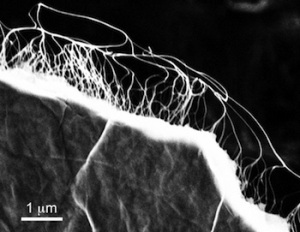Nov 10 2014
Rice University scientist Matteo Pasquali and his team contributed to two new papers that suggest the nano-infused body of a car may someday power the car itself.
 A scanning electron microscope image shows freestanding graphene film with carbon nanotubes attached. The material is part of a project to create lightweight films containing super capacitors that charge quickly and store energy. (Courtesy of Nunzio Motta/Queensland University of Technology)
A scanning electron microscope image shows freestanding graphene film with carbon nanotubes attached. The material is part of a project to create lightweight films containing super capacitors that charge quickly and store energy. (Courtesy of Nunzio Motta/Queensland University of Technology)
Rice supplied high-performance carbon nanotube films and input on the device design to scientists at the Queensland University of Technology in Australia for the creation of lightweight films containing supercapacitors that charge quickly and store energy. The inventors hope to use the films as part of composite car doors, fenders, roofs and other body panels to significantly boost the power of electric vehicles.
The papers appeared in the journal Nanotechnology and the Journal of Power Sources.
Researchers in the Queensland lab of scientist Nunzio Motta combined exfoliated graphene and entangled multiwalled carbon nanotubes combined with plastic, paper and a gelled electrolyte to produce the flexible, solid-state supercapacitors.
“Nunzio’s team is making important advances in the energy-storage area, and we were glad to see that our carbon nanotube film technology was able to provide breakthrough current collection capability to further improve their devices,” said Pasquali, a Rice professor of chemical and biomolecular engineering and chemistry. “This nice collaboration is definitely bottom-up, as one of Nunzio’s Ph.D. students, Marco Notarianni, spent a year in our lab during his Master of Science research period a few years ago.”
“We built on our earlier work on CNT films published in ACS Nano, where we developed a solution-based technique to produce carbon nanotube films for transparent electrodes in displays,” said Francesca Mirri, a graduate student in Pasquali’s research group and co-author of the papers. “Now we see that carbon nanotube films produced by the solution-processing method can be applied in several areas.”
As currently designed, the supercapacitors can be charged through regenerative braking and are intended to work alongside the lithium-ion batteries in electric vehicles, said co-author Notarianni, a Queensland graduate student.
“Vehicles need an extra energy spurt for acceleration, and this is where supercapacitors come in. They hold a limited amount of charge, but with their high power density, deliver it very quickly, making them the perfect complement to mass-storage batteries,” he said.
Because hundreds of film supercapacitors are used in the panel, the electric energy required to power the car’s battery can be stored in the car body. “Supercapacitors offer a high power output in a short time, meaning a faster acceleration rate of the car and a charging time of just a few minutes, compared with several hours for a standard electric car battery,” Notarianni said.
The researchers foresee such panels will eventually replace standard lithium-ion batteries. “In the future, it is hoped the supercapacitor will be developed to store more energy than an ionic battery while retaining the ability to release its energy up to 10 times faster – meaning the car would be powered by the supercapacitors in its body panels,” said Queensland postdoctoral researcher Jinzhang Liu.